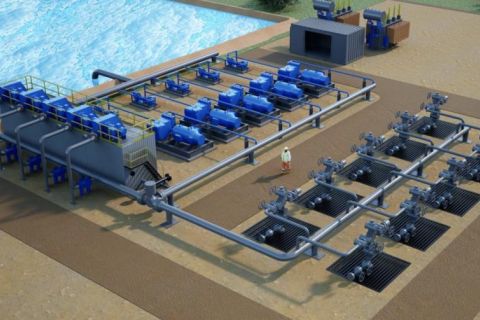Walnut shell filters have been used commercially to remove free oil and suspended solids from water in refineries and in onshore produced water processing for many years.
These types of filters are typically used as part of an overall treatment train as a tertiary separation piece of equipment following upstream oil and suspended solids removal technologies. In typical walnut shell filters, water is introduced in a downward flow through a bed of walnut shells, where oil is adsorbed and suspended solids are filtered. Walnut shells, specifically black walnut shells, have a unique property in that they have an equal affinity for oil and water.
This makes it possible for oil to be captured on the surface of the shells and then scrubbed off during a backwash cycle, allowing oil to be captured for reuse. During forward flow operations where oil and solids are being filtered, the system typically is pressurized, and the water is forced through a bed depth of walnut shells sufficient to achieve the desired performance.
A redesigned filter is now capable of being adapted for both onshore and offshore applications.
Pilot unit
A pilot study conducted at a Stewart Environmental Consultants LLC produced water treatment facility in Colorado was carried out to validate the robustness of the redesigned filters’ internalized backwash system while examining the effects of flux increase from 13.5 gal/m/sq ft to 20.25 gal/m/sq ft on the performance of the filter.
The pilot unit included an internalized backwash system that requires no moving equipment. During the filtration cycle, dirty process water passes through the filter from top to bottom. Free oil and suspended solids are removed as the water passes through the walnut shell medium.
The pilot is a two-vessel system with each vessel being 0.6 m (2 ft) in diameter. Each vessel holds approximately 700 pounds of black walnut shells. The full pilot system is capable of treating 1,440 to 5,760 b/d of produced water at flux rates ranging from 13.5 to 27 gal/m/sq ft. The pilot requires electricity, instrument air, and scrub gas for operation.
Test conditions
The test conditions included a comparison between oil and suspended solids loading when operating the system at a flux rate of 13.5 gal/m/sq ft and 20.25 gal/m/sq ft, validating the recovery capabilities of the newly designed internalized backwash system and evaluating the particle size removal efficiency of the system. The pilot was operated at the test site from April 27 to July 9, 2010, and typically was in operation 24 hours a day.
For the purposes of the study, the following lab and field analytical methodologies were used:
Total suspended solids content was analyzed by a filtration method through a weighed standard glass-fiber filter when the residue retained on the filter was dried to a constant weight at 103 to 105oC (217 to 221°F);
Total oil and grease content was analyzed by extraction with n-hexane followed by gravimetry as the determinative technique according to EPA 1664A; and
Particle size characterization and distribution were completed in the field using a Jorin visual process analyzer, an online instrument used to monitor particle and droplet sizes and concentrations.
Flux rate comparison
For the first eight days of the pilot study, the system ran at a flux rate of 13.5 gal/m/sq ft to obtain background data on oil and solids removal based on the flux rate of the previous generation of the technology. For the remainder of the study, the system operated at a flux rate of 20.25 gal/m/sq ft while other stress test conditions were evaluated.
A comparison was made between the influent and effluent water at the two flux rates. The background flux rate condition at 13.5 gal/m/sq ft was run from May 11 to May 17, 2010, while the comparative test condition at a flux rate of 20.25 gal/m/sq ft was completed between May 18 and May 31, 2010. During these test periods, the only modification to the system was an adjustment to the higher flux rate. All other conditions remained constant.
The average results confirm the increased flux rate was not detrimental to overall removal efficiencies of the system. At either flux rate, the effluent quality is mostly under 5 mg/L of total oil and grease and total suspended solids.
Particle size removal efficiency comparison
Some comparisons were completed at both 13.5 and 20.25 gal/m/sq ft flux rates during the pilot study.
The data indicate that in the evaluation of test conditions at either flux rate, the walnut shell filter removed all particles greater than 20 microns. The majority of the remaining particles were smaller than 10 microns.
There appeared to be only a slight decrease in removal in the 11-20 micron particle size range when the flux was increased from 13.5 gal/m/sq ft to 20.25 gal/m/sq ft. The expectation going into the test was that removal efficiency would decrease across all particles classes, but this was not observed in the comparison. When evaluating at either of the flux rates, greater than 99% of all oil droplets or suspended solids were removed by the system.
The results showed the Siemens Monosep high-flow walnut shell filter pilot system was able to consistently treat the produced water at the pilot site, with the filter pilot system effectively treating produced water of varying concentrations and flux rates while exhibiting successful backwash recovery and bed holding capacity.
Recommended Reading
Energy Transition in Motion (Week of May 3, 2024)
2024-05-03 - Here is a look at some of this week’s renewable energy news, including a 10.5-gigawatt power purchase agreement between Brookfield and Microsoft.
Phillips 66 Weighs Divestments, Targets Renewable Fuel Increase
2024-05-02 - Phillips 66 looks to boost renewable fuels production by 67% through the end of the second quarter 2024 at its Rodeo complex in San Francisco while weighing a potential divestiture of its retail marketing businesses in Austria and Germany.
Sage Geosystems Advances Commercial-scale Energy Storage Facility
2024-05-02 - The 3-megawatt facility in Texas is expected to become the world’s first commercial geopressured geothermal system when it’s commissioned in December.
Integrated RNG: Nopetro Energy on Creating a Circular Economic Model
2024-05-01 - Working with municipalities, Nopetro Energy aims to produce 2 million MMBtu of RNG annually.
Electrifying Permian Could Threaten West Texas Power Grid—Enverus
2024-04-30 - Emissions reduction targets and cryptocurrency mining could double power demand and threaten the grid in West Texas by 2040, according to a report by Enverus Intelligence Research.





